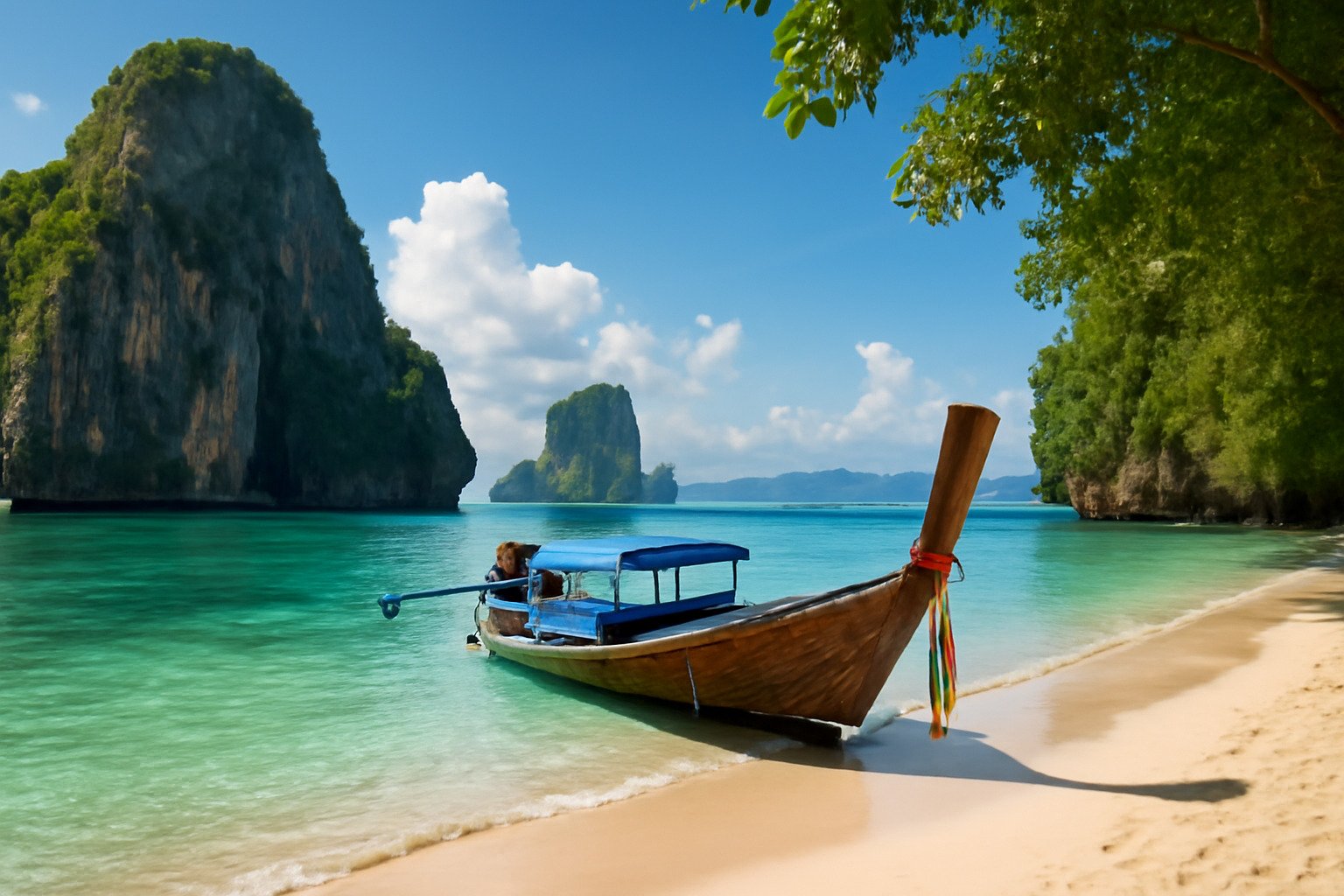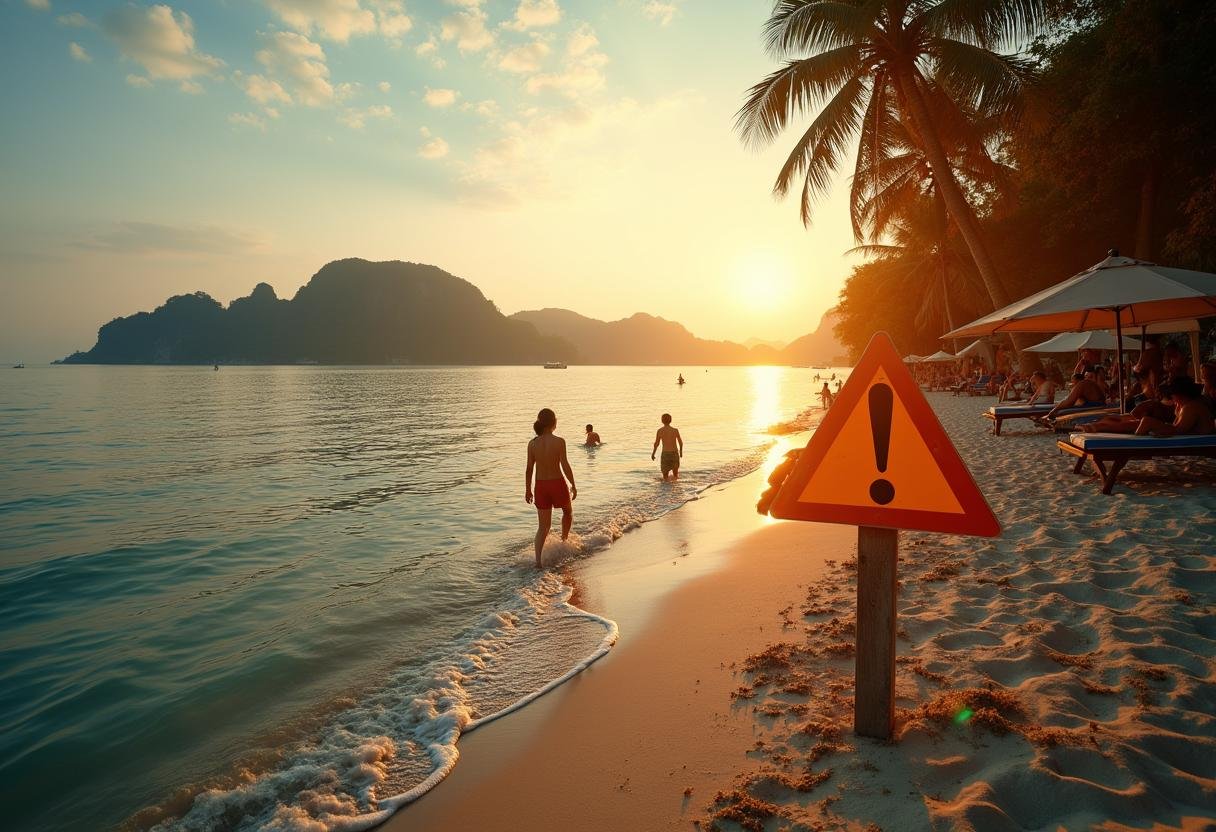Asia Travel Pulse
Thailand’s Tourism Transformation: A Unified Strategy to Achieve Sustainable Growth and Global Leadership in Eco-Friendly Tourism by 2030

Friday, July 25, 2025
Thailand is stepping up to the challenge of sustainable tourism, making a bold commitment to transform its tourism industry by 2030. With the growing demand for responsible travel and the environmental pressures that come with it, Thailand is leading the way as a model for sustainable tourism. The Tourism Authority of Thailand (TAT), along with 20 public and private sector partners, has come together to support the Sustainable Tourism Goals (STGs), marking a crucial moment in the country’s efforts to make tourism more eco-friendly, socially responsible, and beneficial to local communities.
The vision for 2025 and beyond is clear: Thailand aims to create a tourism sector that not only protects its stunning natural landscapes but also fosters inclusive growth and sustainable practices that help local communities thrive. By signing a Letter of Intent, a broad coalition of organizations—ranging from government agencies to major corporations—has set the stage for a sustainable transformation that will shape the future of tourism in the country.
This landmark collaboration is focused on creating a tourism industry that is environmentally responsible, socially inclusive, and resilient in the long term. It goes beyond the typical environmental goals by also ensuring that tourism contributes to local economic growth and benefits communities. The country’s commitment includes reducing emissions, using resources more efficiently, and protecting biodiversity, all while maintaining the tourism sector’s competitiveness on the global stage.
Thailand is committed to ensuring that its tourism industry is not just a driver of economic prosperity but a sustainable model for other nations to follow. By 2030, the goal is clear: to lead the way in sustainable tourism, setting standards that align with global efforts while preserving the country’s rich natural and cultural heritage for future generations.
Thailand’s Commitment to Sustainability: A Unified Approach
Thailand’s tourism industry has long been a key economic driver. In recent years, however, sustainability has become a primary focus, especially as global travelers are increasingly seeking eco-conscious destinations. In response, the Tourism Authority of Thailand, together with 20 other public and private sector partners, has signed a groundbreaking Letter of Intent that paves the way for a sustainable tourism future.
The agreement builds on Thailand’s commitment to the United Nations Sustainable Development Goals (SDGs), adapting global sustainability targets into actionable steps within the tourism sector. Under the leadership of the TAT, Thailand aims to strike a balance between economic growth, environmental preservation, and social equity, ensuring the benefits of tourism are shared with all segments of society, including local communities and small businesses.
Key Stakeholders Driving Change
A pivotal aspect of this agreement is the collaboration between public and private sectors, creating a powerful network for promoting sustainability. The signatories include a wide range of stakeholders, with eight key government organizations such as the Department of Tourism, Department of Climate Change and Environment, and Thailand Greenhouse Gas Management Organization. Additionally, 13 prominent private sector entities, including the Thai Hotels Association, the Tourism Council of Thailand, and renowned corporations like Minor International and Asset World Corporation, are also part of this historic agreement.
This cross-sector collaboration aims to implement best practices, set clear guidelines, and adopt sustainability certifications that ensure tourism businesses operate in environmentally and socially responsible ways.
Key Sustainable Tourism Goals for 2030
The strategic vision for 2030 focuses on several key areas that align with global sustainability practices. The primary goals include:
- Emissions Reduction: With the global emphasis on climate change, Thailand aims to reduce its carbon footprint through energy-efficient practices and by promoting the use of renewable energy in tourism infrastructure.
- Resource Efficiency: Encouraging businesses to optimize their resource consumption is a core focus, with the tourism sector expected to lead by example in minimizing waste, conserving water, and reducing energy use.
- Biodiversity Protection: Thailand’s rich biodiversity is a key asset for the tourism sector, and measures will be taken to preserve ecosystems while promoting sustainable eco-tourism practices.
- Community Engagement: Ensuring that tourism benefits local communities is essential. This includes involving local residents in tourism planning, supporting local businesses, and ensuring that tourism revenue reaches the grassroots level.
Each of these goals is designed not just to enhance Thailand’s appeal as a destination but also to ensure that growth is sustainable and equitable, benefiting both the economy and the environment.
Thailand’s Strategic Initiatives for Sustainability
As part of the roadmap to achieve these ambitious goals, Thailand has rolled out specific initiatives that target critical aspects of sustainability within the tourism sector. Among these are the STGs STAR certification, a tool designed to help businesses meet sustainability standards, and the Carbon Footprint Hotels Platform, which supports hotels in measuring and reducing their environmental impact.
In addition, the Thailand Tourism Awards will be updated to recognize businesses and organizations that lead the way in sustainability. These measures will be supported by government initiatives such as the Thailand Green Plan 2030, which promotes the certification of tourism sites and businesses to ensure they meet the highest environmental standards.
A noteworthy initiative is the effort to elevate Phuket Hotels to Green Hotel Plus status. This initiative is part of a broader effort to raise environmental awareness within the hospitality sector and push for cleaner, greener operations across the country’s most visited tourist destinations.
The Road Ahead: Collaborative Efforts and Progress Review
While the Letter of Intent signed in 2025 is non-binding, it creates a shared vision and a clear framework for collective action. Progress towards the set goals will be reviewed annually, ensuring that stakeholders remain accountable and that efforts are aligned with the objectives of the 2030 agenda. This review mechanism will allow Thailand to track its advancements and make necessary adjustments to strategies and policies, ensuring the country stays on track to meet its sustainable tourism goals.
Furthermore, TAT’s leadership in this initiative signals a renewed focus on long-term resilience for Thailand’s tourism industry. The agency recognizes that sustainable tourism is not just a trend but a necessary evolution for the future of the industry.
Supporting Tourism Businesses: A Path to Sustainability
To support businesses in adopting sustainable practices, the Tourism Authority of Thailand (TAT) is focusing on capacity-building and offering resources to help businesses transition to more sustainable models. One of the key strategies is to encourage the adoption of international sustainability certifications, such as the Thailand Good Travel Seal, which serves as a marker of responsible tourism practices. This certification aims to boost consumer confidence by identifying businesses that meet the highest standards of environmental and social responsibility.
Through these initiatives, TAT hopes to create an ecosystem where sustainable tourism is the norm, not the exception, and where businesses of all sizes are incentivized to invest in practices that promote long-term environmental health and social equity.
Final Thoughts: Thailand’s Sustainable Tourism Legacy
Thailand’s commitment to sustainable tourism is setting a powerful example for countries around the world. Through its collaborative efforts, clear goals, and practical initiatives, the nation is poised to lead the way in sustainable tourism by 2030. By focusing on emissions reduction, resource efficiency, biodiversity preservation, and community involvement, Thailand is not only protecting its natural heritage but also ensuring that tourism remains a key driver of economic growth for generations to come.
The roadmap outlined by TAT and its partners promises to create a tourism landscape that thrives on responsibility, inclusivity, and resilience. As global travelers increasingly prioritize sustainability, Thailand’s leadership in this field will ensure that it remains a top choice for eco-conscious tourists seeking to explore the beauty and culture of one of Southeast Asia’s most remarkable destinations.
Asia Travel Pulse
America, Asia, Europe, Middle East, and Africa Drive the Future of Travel with Augmented Reality Technologies Projected to Boost the Market to 29.58 Billion by 2025

Saturday, July 26, 2025
Augmented Reality (AR) has been one of the most exciting technologies in the travel and tourism space in recent years. As AR can augment and enable the travel experience, it has been transforming the way tourists interact with destinations, services, and booking services. This market has already been growing rapidly, that growth will now just accelerate even faster in the future. The case for AR in travel This demand for AR comes from quite a few directions, including immersive travel experiences, imaginative solutions for navigation, cultural storytelling, connecting with your customers and more.
Projected Market Growth for Augmented Reality in Travel and Tourism by 2025
The augmented reality market within the travel and tourism sector has witnessed impressive expansion, and its outlook for the coming years is even more optimistic. By 2024, the market is anticipated to generate \$21.44 billion in revenue, with a forecasted rise to \$29.58 billion by 2025. This growth equates to a significant compound annual growth rate (CAGR) of 38.0%. The surge in market size is largely attributed to the improvement in user experiences, the support of local businesses, and the increasing integration of social media, which encourages travel and tourism promotion. Positive user reviews and the growing interest in experiential travel are also contributing factors to the market’s expansion.
Augmented Reality Market Outlook for 2029
Looking ahead to 2029, the market for augmented reality in travel and tourism is set to grow exponentially. With an anticipated market value of $109.13 billion, the industry will experience a CAGR of 38.6% over the next five years. The increase in market demand can be attributed to a range of applications in key tourism segments such as travel booking, educational tourism, nature-based adventures, and the sharing of user-generated content. As travelers become increasingly connected to digital tools, AR will continue to be a central player in enhancing their experiences. Notably, wearable AR devices, wayfinding solutions, contactless interactions, and cultural storytelling are expected to become major trends during the forecast period.
Key Drivers Powering Market Expansion
Several key drivers are contributing to the rapid expansion of the augmented reality market in travel and tourism. The increasing demand for travel—spanning leisure, business ventures, and sports activities—has spurred interest in smart tourism and AR applications. As tourism becomes more personalized, travelers are looking for ways to engage in more interactive and immersive experiences. In 2023, the United Kingdom saw a surge in foreign visitors, with 38 million arrivals, representing a 21.7% increase from the previous year. These travelers contributed $39.4 billion to the UK economy, an increase of $5.84 billion. The adoption of AR technologies in travel is helping to meet these increasing demands by offering tourists a more captivating and informative experience, whether for navigation, entertainment, or cultural exploration.
Trends Disrupting the Augmented Reality in Travel and Tourism Market
A growing number of businesses in the augmented reality sector are collaborating to develop innovative products and services that enhance the travel experience. By leveraging shared resources and expertise, strategic alliances are accelerating the development of new AR applications in travel and tourism. A prime example is the partnership between ARway.ai and AI Safer, announced in January 2023. This collaboration focuses on improving visitor engagement at cultural sites and museums in Saudi Arabia, using AR navigation technology. The aim is to create immersive experiences that help visitors deepen their understanding of the country’s rich cultural heritage, showcasing the growing potential for AR in heritage tourism.
Emerging Segments and Market Expansion
The augmented reality in travel and tourism market is segmented into several key areas, which provide various growth opportunities for both developers and investors:
By Component:
Hardware: AR glasses, mobile devices, and head-mounted displays (HMDs)
Software: AR applications, development tools, and content management systems (CMS)
Services: Consulting, integration, and maintenance services
By Technology:
Augmented Reality (AR) and Virtual Reality (VR)
By Application:
Hospitality
In-flight entertainment
Travel booking services
AR gamification
Navigation solutions
These segments highlight the diverse applications of AR technology, from enhancing travel booking experiences to enriching in-flight entertainment and improving navigation and gamification. As demand grows, additional subsegments such as educational tourism and cultural storytelling will continue to drive growth.
Market Leaders in the Augmented Reality Travel and Tourism Sector
Numerous international companies are at the forefront of driving innovation in the augmented reality travel and tourism sector. These players include technology giants such as Apple Inc., Google LLC, and TeamViewer SE, as well as travel industry leaders like Delta Air Lines, Marriott International, and Booking.com. These companies are shaping the future of travel through their investments in AR technologies, which enhance various aspects of the travel journey. Additionally, travel brands like TUI Group, Airbnb, and Hilton Worldwide are also exploring the potential of AR to deliver superior customer experiences and expand their service offerings.
Regional Market Insights: North America and Asia-Pacific
As of 2024, North America remains the largest regional market for augmented reality in travel and tourism. The adoption of AR technology in the region is expected to continue its strong growth due to widespread interest in enhancing customer engagement and the region’s technological infrastructure. However, Asia-Pacific is poised to become the fastest-growing region in the coming years, driven by increasing tourism in countries such as China, Japan, and India. The Asia-Pacific region is expected to see rapid adoption of AR in tourism due to its large population, growing middle class, and increasing use of mobile devices and wearable technology.
AR in Tourism- A New Era of Innovation
It’s fair to say that the AR travel and tourism market is going through an interesting expansion phase at the moment. With immense expansion expected in the year ahead, the industry is expected to grow to be an essential part of travel. With global tourism on the rise and AR technology picking up steam, the industry should see more personalized, more immersive, and more efficient travel experiences on the horizon. For both tourists and organizations, AR applications that allow users’ easy navigation, inspiring cultural immersion, and customized service will be of great interest. The reality is this, as the technology develops the augmented reality in travel and tourism sector will continue to redefine the challenge for seeing the world, in turning all travel experiences into a more interactive, engaging opportunity than ever before.
Download report here: https://www.thebusinessresearchcompany.com/report/augmented-reality-in-travel-and-tourism-global-market-report
Asia Travel Pulse
Thailand Travel Warning: What To Expect And How To Stay Safe

Saturday, July 26, 2025
Thailand is an evergreen favourite among holidaymakers, known for its beautiful beaches, bustling cities, and of course its rich cultural heritage. The appeal of places like Bangkok, Phuket, and Chiang Mai has only strengthened over the years, particularly as global awareness has grown. Yet in the past few days, the United States Department of State’s “do not travel” advisory specifically for Thailand has been relaxed to “exercise increased caution” for a turbulent situation in some areas. This change in advisory is a useful reminder that, even in the most popular tourist areas of the world, problems can still occur.
The New Warning Has Not Been Lifted: What Prompted It?
On Friday, the United States State Department officially escalated its travel advisory for Thailand from Level 1, “exercise normal precautions,” to Level 2, “exercise increased caution.” This revision to the Travel Advisory updates information on civil unrest and ongoing insurgent attacks in southern Thailand’s Yala, Pattani, and Narathiwat provinces. Violence persists in these regions caused by the conflict between the Thai military and armed militants, which has occasionally resulted in incidental injuries and deaths of civilians.
The warning also noted that 17 districts remain in both provinces under declared states of emergency as a result of continuing violence. While the conflict has largely been low in intensity, there is the risk of exposure for travelers in the affected regions. But it’s not forgettable that these outbreaks are localised mostly in the south and elsewhere have minimal effects in popular travel spots such as Bangkok, Chiang Mai, and Phuket.
The Thai-Cambodian Border: A More Dire Caution
General Travel Advisory for Thailand raised to Level 2 from Level 1 & US Department of State offers the highest Level 4 “Do Not Travel” warning to areas within 50 km of the Thai-Cambodian border. This zone has been the site of continuous armed struggles between the Thai armed forces and the Cambodian Army. The fighting, involving artillery and rocket fire, has caused civilian casualties, and the Thai government has issued evacuations in some areas.
The advisory makes it clear that there is an increased risk of violence for people in or near this border region. For travelers, that means avoiding all but essential movement to these areas, for the time being. The U.S. government has also underscored that due to the conflict, the U.S. is limited in what it can do to help in these provinces. As a result, if anyone decides to travel to Thailand, they are strongly urged to have an exit plan that does not depend on U.S. government assistance.
Travel Advisory Experimental Details and Recommendations
Updated September 2016. The Department of State is concerned that American citizens will be victims of terrorist actions in the Southeast Asian countries of Malaysia and Thailand. The alert is intended to provide travelers with an increased level of information and guidance in the event of problems before or during their trip.
For those who plan to travel to Thailand, it is suggested that:
Stay in known tourist areas: The main tourist destinations such as Bangkok, Chiang Mai, and Phuket are not affected by the violence in the far south. The areas remain safe and accessible to tourists.
Stay out of the southernmost provinces: Travelers should steer clear of the Yala, Pattani, and Narathiwat provinces, where the government has been battling a low-key but persistent insurgency, and unrest can flare up at any moment.
Stay away from the Thai-Cambodia border: The U.S. Department of State has issued a Level 4 warning that “security and safety risks” remain high, due to the consistent armed conflict between the Thai and Cambodian military near the Thai-Cambodia border, within an area within 31 miles of the border.
If visiting areas of Thailand affected by unrest, have an evacuation plan that does not rely on U.S. government assistance, since emergency services are limited in certain areas.
Why Tourists Still Flock to Thailand
Thailand is a significant international travel center of tourism, and with tens of millions of tourists visiting and experiencing its bustling metropolises, tranquil beaches, and ancient culture, still a heavily-inhabited country. Its tourist infrastructure is mature, and most tourist hotspots will not pose a risk for your safety, so it’s a good destination for people looking for both relaxation and adventure.
Tourists heading to Thailand are unlikely to be disturbed by the unrest in its far southern reaches, and they can still experience the country’s top-rated beaches, its daily massive markets, and ancient temples. Whether exploring Bangkok’s temples, the island of Phuket with its stark beaches, or the quiet mountains of Chiang Mai, Thailand remains a land of discovery for tourists the world over, eager to take in the wonders of its singular culture.
Conclusion: A Wary, But Not Unwelcoming, Destination
In summary, the fresh travel advisory from the US State Department continues to warn about security in parts of Thailand but does not condemn the entire country. For the average tourist, Thailand is still a relatively safe and charming must-see destination. With a little vigilance (especially at some places) tourists can avoid unnecessary problems and enjoy the stunning splendour and culture of Thailand.
Travelers should continue to stay informed, check travel advisories, and listen to local authorities and hotel staff for guidance to ensure a safe and enjoyable visit, as always. Whether you’re a city person or a beach lover, Thailand is still among the most popular destinations in Southeast Asia—just know where not to go and plan your trip accordingly.
(Source: U.S. Department of State, Thailand Ministry of Tourism, National Institute of Statistics and Geography)
Asia Travel Pulse
Singapore’s First-Ever Light Show Illuminates The Botanic Gardens

Singapore’s iconic Botanic Gardens has kicked off a year-long celebration in honour of several national and institutional milestones. Leading the festivities is the Gardens’ first-ever light show, which will illuminate two key landmarks until August 10, 2025.
Launched on July 18, 2025, the event marks 10 years since the Gardens site was inscribed as Singapore’s first and only UNESCO World Heritage Site. It also commemorates 150 years of the Singapore Herbarium and the Gardens’ Library of Botany and Horticulture, as well as the 30th anniversary of the National Orchid Garden. The festivities, including the Singapore Botanic Gardens light show, are part of the National Parks Board’s (NParks) Celebrations, supporting the nation’s 60th year of independence.
Also, read our ultimate guide to Singapore Botanic Gardens.
How to catch the daily light shows at Swan Lake and Tanglin Gate?
Running from July 19 to 27, 2025, the Singapore Botanic Gardens Heritage Festival returns for its 10th edition with more than 40 free activities across the Gardens. And among the headline acts is the daily light shows at Swan Lake and Tanglin Gate from 7:30 pm to 10 pm, set to orchestral works by the Singapore Symphony Orchestra (SSO).
Visitors can expect two celebrated compositions: ‘Dengan Semangat Yang Baru’ by Syafiqah ‘Adha Sallehin (first performed at SSO’s 2021 National Day Concert) and ‘Where That River Always Flows’ by Chua Jon Lin (debuted in 2023). The experience extends to light installations at the Bandstand, the Clock Tower at Orchid Plaza, and the Palm Court near the Nassim Visitor Services Centre, all of which are worth carrying your camera for.
Beyond Singapore Botanic Gardens’ light show
Want to explore beyond Singapore’s Botanic Gardens light show? The festival’s full programme includes live music, film screenings, guided walks and interactive workshops. There’s also a science-themed hands-on lab where visitors can try DNA extraction using bananas and cell staining with onion roots, which we can confidently call a very rare opportunity to access the research work behind the Gardens’ conservation efforts.
Throughout the year, the public can also explore the following rotating and permanent exhibitions across the Gardens:
- ‘Planting Memories’ (CDL Green Gallery and others)
- ‘Roots of Knowledge’ (Library of Botany and Horticulture)
- ‘Botanical Art Worldwide 2025 Singapore’ (Botanical Art Gallery)
To commemorate the event, visitors can collect a free Discovery Passport, developed in collaboration with LASALLE College of the Arts, and gather commemorative embossed stamps at 10 designated stops, including landmarks such as the Learning Forest and Swan Lake. The passports are available at the five Visitor Services Counters throughout the Gardens.
You can also visit the National Parks website to learn about the coinciding Orchid festival, launch of the second edition of ‘Gardens of Perpetual Summer’, and Singapore Mint’s special set of medallions featuring the Bandstand, the Singapore Herbarium, and Burkill Hall, which will be available for purchase.
(Feature image credit: National Parks Board)
Related | Explore Everton Park, Singapore’s Hipster Neighbourhood
Note:
The information in this article is accurate as of the date of publication.
Written By
-

 Brand Stories5 days ago
Brand Stories5 days agoBloom Hotels: A Modern Vision of Hospitality Redefining Travel
-

 Brand Stories14 hours ago
Brand Stories14 hours agoCheQin.ai sets a new standard for hotel booking with its AI capabilities: empowering travellers to bargain, choose the best, and book with clarity.
-

 Destinations & Things To Do6 days ago
Destinations & Things To Do6 days agoUntouched Destinations: Stunning Hidden Gems You Must Visit
-

 AI in Travel6 days ago
AI in Travel6 days agoAI Travel Revolution: Must-Have Guide to the Best Experience
-

 Brand Stories3 weeks ago
Brand Stories3 weeks agoVoice AI Startup ElevenLabs Plans to Add Hubs Around the World
-

 Brand Stories2 weeks ago
Brand Stories2 weeks agoHow Elon Musk’s rogue Grok chatbot became a cautionary AI tale
-

 Asia Travel Pulse3 weeks ago
Asia Travel Pulse3 weeks agoLooking For Adventure In Asia? Here Are 7 Epic Destinations You Need To Experience At Least Once – Zee News
-

 Destinations & Things To Do11 hours ago
Destinations & Things To Do11 hours agoThis Hidden Beach in India Glows at Night-But Only in One Secret Season
-

 AI in Travel3 weeks ago
AI in Travel3 weeks ago‘Will AI take my job?’ A trip to a Beijing fortune-telling bar to see what lies ahead | China
-

 Brand Stories3 weeks ago
Brand Stories3 weeks agoChatGPT — the last of the great romantics











You must be logged in to post a comment Login